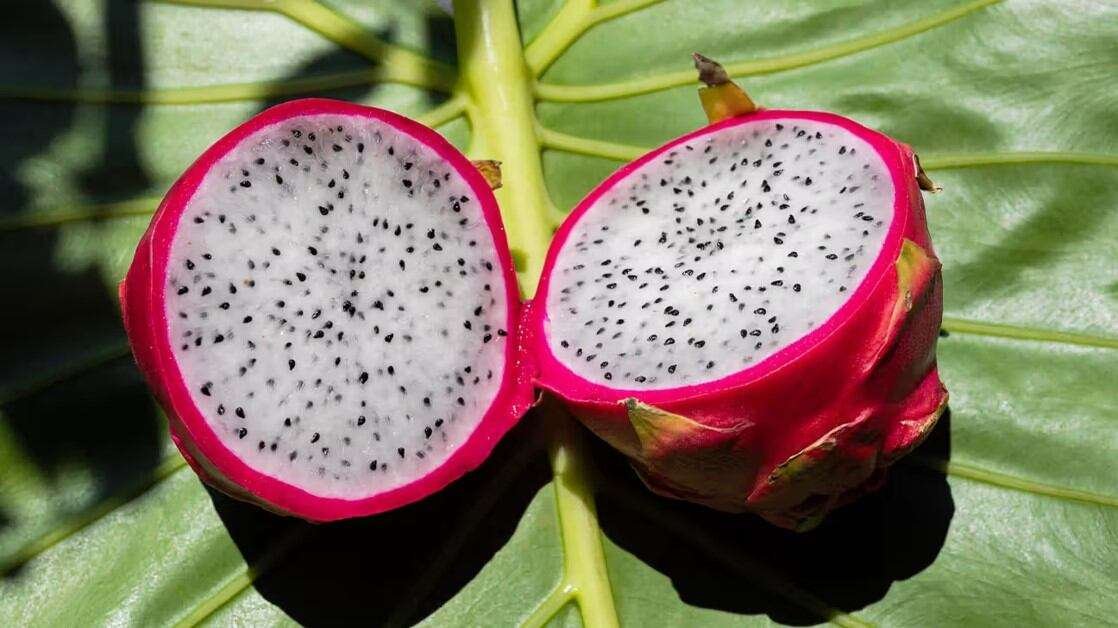How to Grow Dragon Fruit Plant with tips & tricks. Grow and care for dragon fruit plants successfully.
What you will read in this Blog?
ToggleWhat is Dragon Fruit?
Dragon fruit, also known as Hylocereus undatus, is a beautiful tropical fruit that grows on a succulent that resembles a climbing cactus. The dragon fruit plant, which is native to Mexico and Central America, is currently grown in a variety of tropical and subtropical climates around the world.
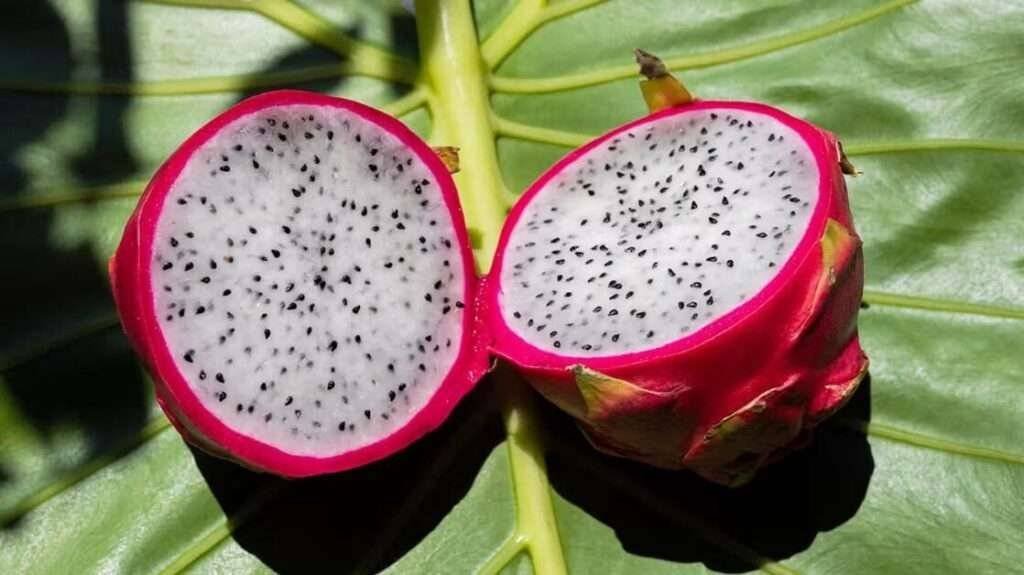
How Dragon Fruit Look Like?
Its unusual look is defined by bright pink or yellow skin with green scales that resemble dragon scales, hence the name.
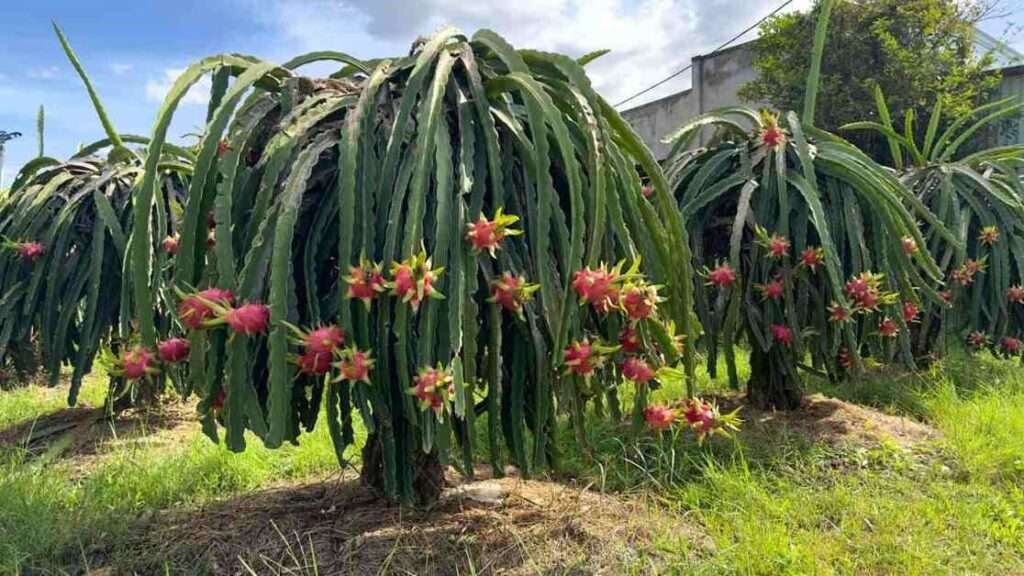
The flesh of Dragon Fruit
The fruit’s flesh is white or red, with tiny black seeds that create a visually dramatic contrast.
Climate Needed for Dragon Fruit
Despite its fearsome appearance, the dragon fruit plant thrives in hot and arid climes, making it ideal for cultivation in dry areas.
How to Grow Dragon Fruit?
The plant usually blooms at night, producing huge, fragrant flowers that endure only one night and are pollinated by nocturnal animals such as bats and moths.
Fruit
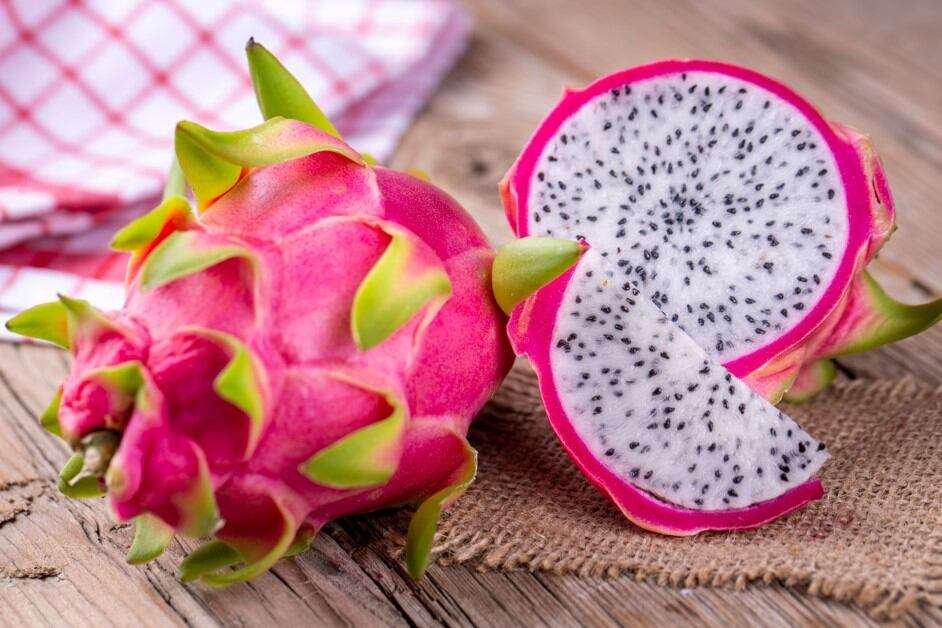
Once fertilized, these flowers give way to fruit, which usually ripens in 30-50 days.
Benefits to Grow Dragon Fruit
- Dragon fruit is visually appealing and provides numerous health advantages, including antioxidants, vitamin C, fibre, and other critical elements.
- Its mild, sweet flavour, with faint undertones of kiwi and pear, makes it a versatile ingredient in various dishes, including smoothies, salads, desserts, and drinks.
- With its captivating beauty and nutritional potential, the dragon fruit plant continues attracting producers and customers, evoking the fascination with exotic tropical fruits.
Grow Dragon Fruit from Seed
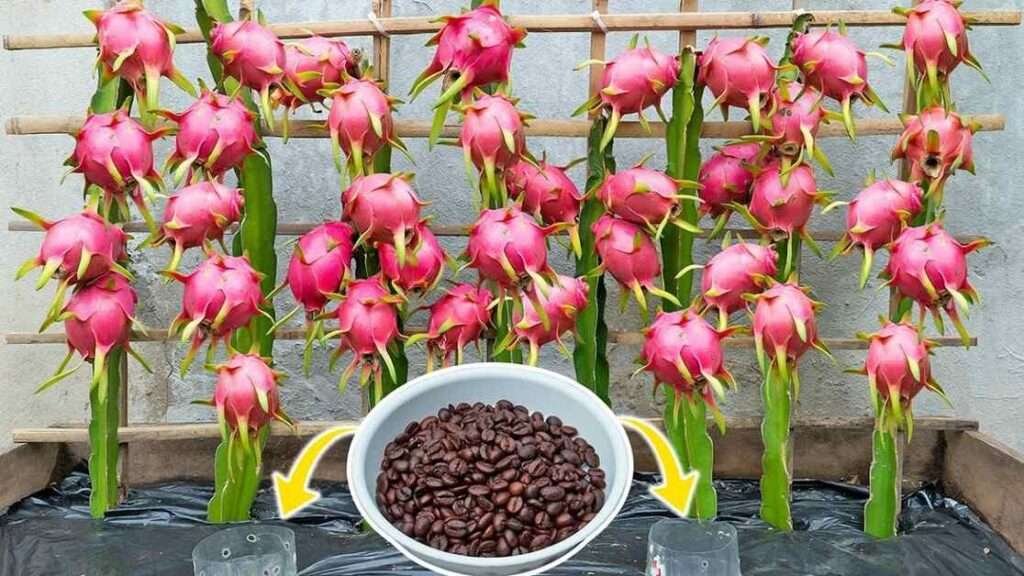
Selection of Quality Seed to Grow Dragon Fruit Plant
Selecting the correct dragon fruit seeds is essential in establishing a prosperous crop. Dragon fruit, also known as pitaya, comes in a wide range of cultivars, each with distinct features. To begin, obtaining seeds from a reputed provider or a reliable source is critical to ensure quality and viability.
Consider the Temperature of Your Area
Consider your area’s temperature and growing conditions, as various types may be better suited to specific regions. Choose seeds from mature, healthy fruits, which are more likely to generate vigorous plants.
Prefer Seed
In addition, they prefer seeds from self-pollinating types for ease of cultivation. When inspecting seeds, seek plumpness and uniformity while avoiding broken or shriveled ones.
Recommendation of Seed
It is also recommended to soak seeds in water for 24 hours before planting to increase germination. Whether you like brilliant pink flesh, sweet flavor, or prolific fruiting, compare dragon fruit varieties to find the best fit for your preferences and growing conditions.
Soil for Growing Seed
Finally, consider the value of adequate soil preparation and continual care in supporting the growth of your dragon fruit plants from seed to harvest. With careful selection and attention to detail, you can lay the groundwork for a plentiful dragon fruit harvest that will please both the tongue and the eye.
Grow Dragon Fruit Plant with Cuttings
Welcome, dear plant fans, to the fascinating world of dragon fruit growing! While beginning plants from seeds is one method, today we’ll look at the exciting world of growing dragon fruit from cuttings. This approach provides a faster and more consistent way to reproduce these exotic beauties, resulting in a fruitful crop in no time. Join me as we learn how to select, store, and plant cuttings to grow into healthy dragon fruit plants.
1. Choosing the Best Cutting:
Choosing the best cutting is crucial for growing dragon fruit from cuttings. Look for healthy, mature stems on a well-established dragon fruit plant. Look for pieces of stem that are 12-18 inches long and show no symptoms of damage or disease. Choose segments with at least three nodes, as these are the sites from which new roots will grow. Select dragon fruit cuttings from a variety appropriate for your climate and growing circumstances for the best results.
2. Properly preserve Cuttings for Future Use:
After receiving your cuttings, preserving them properly is crucial to ensure their viability. If you’re not ready to plant them immediately, cover the cut ends in damp paper towels to keep them hydrated. Area: areaThe wrapped cuttings are in a plastic bag and kept in a cold, dark area until ready to plant. Avoid exposing the cuttings to direct sunlight or excessive temperatures, as they may dry or decay.
3. How to Plant Dragon Fruit Cuttings:
Prepare the planting location before planting the cuttings. Dragon fruit thrive in sunny, warm climates, so choose a spot with well-drained Soil and enough sunlight. Dig a hole deep enough to accommodate the length of the cutting, leaving at least one node below the soil surface. Gently insert the cutting into the hole, careful not to injure the delicate roots. When planting numerous cuttings, keep them at least 6 feet apart to allow for enough development.
4. Cutting Soil:
Choosing the suitable Soil is crucial for successful dragon fruit cuttings. Choose a well-drained combination of equal parts sand, perlite, and peat moss. This mixture provides the ideal balance of aeration, moisture retention, and nutrient availability for young roots to thrive. Avoid hard or compacted soils since they might give soggy conditions that cause the cuttings to decay. To increase fertility and promote healthy growth, consider supplementing the Soil with organic matter, like compost or old manure.
5. irrigation Dragon Fruit Cuttings:
After planting, irrigation is essential to build roots and encourage growth. Begin by thoroughly wetting the Soil around the base of each cutting until it is evenly moist but not soggy. Continue to water regularly, keeping the Soil wet but not saturated. Increase watering frequently during hot weather or dry seasons to keep the Soil from drying out. However, avoid overwatering since excess moisture can cause root rot and other fungal diseases. Regularly monitor soil moisture levels and adapt your watering schedule for changing environmental circumstances.
Conclusion:
Growing dragon fruit from cuttings is a gratifying experience that enables the easy propagation of these intriguing plants. You may grow blooming dragon fruit plants that will please both the eye and the palate by carefully selecting, storing, and planting cuttings and providing them with a suitable Soil and watering regimen. So roll up your sleeves, grab your gardening tools, and set off on this fantastic voyage of dragon fruit cultivation—you’re in for a genuinely enchanting experience!
FAQs about How to Grow Dragon Fruit
In this guide, we will answer how to grow dragon fruit with tips and tricks. We will give answers to essential FAQs about how to grow dragon fruit. So please stay connected with us for important tips.
How long does it take to grow dragon fruit?
Dragon fruit plants typically have two to three years gestation before bearing fruit. This timescale demonstrates the plant’s meticulous nature, requiring the ideal balance of temperature, sunlight, and well-drained soil to thrive.
Stages of How to Grow Dragon Fruit
In the early stages, the plant produces roots, setting the groundwork for future growth. As time passes, the plant evolves, growing complicated tendrils that climb and tangle, eventually forming the recognizable cactus structure. Throughout this transforming process, farmers develop patience as they care for and tend to their plants.
As time passes, the plant grows, and symptoms of fruitfulness appear.
Delicate Blossoms to Grow Dragon Fruit
Delicate blossoms adorn the cactus-like branches, indicating that hard work and perseverance will pay off. Finally, after years of care, the dragon fruit plant bestows its treasured bounty on its guardians. The vibrant colors of its exquisite fruit emerge, a monument to the enduring patience and unwavering commitment required during the cultivation process. Thus, the question of how long it takes to develop dragon fruit is that if you take care of it, you will soon get fruit. If not, then not.
Does dragon fruit need the sun to grow?
With its spectacular appearance and exotic attraction, Dragon fruit is a tropical marvel that farmers and customers adore.
The climate to grow Dragon Fruit
This succulent fruit belongs to the cactus family and thrives in warm climates. The question arises: does dragon fruit require sun to grow? The answer is in the heart of its roots.
to grow dragon fruit properly
Dragon fruit is native to Mexico and Central America and requires enough sunlight to develop properly. For this fruit-bearing cactus, sunlight is a requirement rather than a luxury.
For Photosynthesis
Sunlight is essential for photosynthesis, which powers all green plants, including dragon fruit. Plants need this sophisticated mechanism to transform light energy into chemical energy, which fuels their growth and development.
For Taste
Furthermore, sunshine impacts the fruit’s color, taste, and quality. Inadequate solar exposure can lead to stunted growth, pale fruit, and lower production.
For Beautiful Harvesting
To establish robust dragon fruit plants and assure a bountiful harvest, ample sunlight is required. While sunshine is necessary, moderation is crucial. Excessive exposure to direct sun can blister the delicate cactus stems and stunt growth.
If You Want to Grow Dragon Fruit Plants Healthy
Thus, balancing sun exposure and proper shade is critical for growing healthy dragon fruit plants. In essence, sunlight drives the dragon fruit cactus’ vivid growth and succulent fruits, making it a necessary component in its growing process.
Do dragon fruits need water?
Dragon fruits, also known as pitayas, are noted for their brilliant colors, exotic look, and refreshing flavor. As growers and fans delve into the complexities of cultivating these tropical treats, one common concern arises: Do dragon fruits require water?
The explanation lies in the plant’s natural habitat and distinct physiology. Dragon fruit plants are native to desert climates such as Central and South America, and they have evolved to thrive in conditions where water is rare. While drought-resistant, they require appropriate moisture, particularly during the early growth and fruit formation stages.
Young Dragon Fruit
Young dragon fruit plants need frequent watering to develop robust root systems and encourage healthy growth.
Mature Dragon Fruit
Once mature, these succulent plants are more resistant to dry conditions but still require constant hydration, especially during flowering and fruiting.
Proper Irrigation to grow dragon fruit
Proper irrigation measures, such as deep watering and mulching, help to preserve soil moisture and reduce water stress.
Essential Tips to Grow Dragon Fruit
Furthermore, the frequency and amount of water required may differ depending on climate, soil type, and container size for potted plants.
Overwatering
Overwatering is harmful to plants since it causes root rot and other problems. In essence, while dragon fruits can withstand drought, adequate water is required for optimal growth, flowering, and fruit development, resulting in copious harvests of these unique delicacies.
Is To Grow Dragon Fruit Expensive?
For Its Beauty
Dragon fruit’s brilliant colors and exotic look typically pique interest in its cost. Despite its beautiful appearance, the price of dragon fruit might vary depending on location, seasonality, and availability.
Imported Dragon Fruit
Dragon fruit may be more affordable in areas where it is grown locally. However, the cost might be significantly greater in locations where dragon fruit is imported or available in restricted quantities, owing to climate limits.
Varieties of Dragon Fruit
Furthermore, the variety of dragon fruit can affect its price, with certain species being more sought after due to their taste or nutritional value.
For Its Flavor
While some may consider dragon fruit to be more expensive than other fruits, its distinct flavor, vitamin richness, and visual attractiveness frequently outweigh the expense for those looking for a delicious and nutritious culinary experience.
Global Fruit
Furthermore, the growing global popularity of dragon fruit has resulted in increased production efforts, which may drive prices lower in some areas as economies of scale take effect.
Factors of Expensiveness
Finally, whether dragon fruit is considered expensive is a matter of opinion and context, influenced by factors:
- Ranging from personal budget constraints
- To cultural preferences.
However, for many, the fascination of this beautiful fruit extends beyond its monetary value, providing a sensory trip that tantalizes the taste buds and adds a touch of exotic elegance to any culinary excursion.
Can We Grow Dragon Fruit as Indoor?
Dragon fruit, also known as pitaya, is a visually attractive tropical fruit notable for its bright pink or yellow surface and speckled green scales.
cIRCUMSTANCES TO GROW DRAGON FRUIT
Dragon fruit thrives in warm areas and is often grown outside in regions such as Southeast Asia, but it may also be produced indoors with the correct circumstances.
Possible as Indoor, But in some conditions
Many fans ask if it is possible to cultivate dragon fruit plants indoors due to their unique cactus-like appearance and exotic attractiveness. What’s the answer? Yes, it is possible, but only under certain conditions:
- Light
- temperature
- soil
- space
These are all important considerations for growing dragon fruit indoors.
resources TO GROW DRAGON FRUIT
Dragon fruit plants are epiphytic cacti. Therefore, they enjoy bright, indirect sunshine, making them ideal for interior areas with plenty of natural or enhanced artificial lighting.
Temperature to GROW DRAGON FRUIT
Furthermore, a continuous temperature range of 65°F to 80°F (18°C to 27°C) is required for optimal growth.
Soil
Dragon fruit also thrives in well-drained soil with a slightly acidic pH, which mimics its natural tropical home. Container gardening is a popular approach for growing dragon fruit indoors since it allows for better soil control and facilitates periodic trimming and upkeep.
Disadvantages of growing as an indoor
While indoor dragon fruit plants may not grow as large as their outdoor counterparts, they may produce an astounding harvest of delectable fruit with proper care and attention.
Provide Bright Light
Cultivating dragon fruit inside, whether in a sunny corner of a living room or a dedicated greenhouse space, can be a satisfying and visually appealing addition to any indoor garden or urban paradise, delivering aesthetic appeal and delectable harvests all year.
Important
With the appropriate attitude, even city inhabitants may appreciate dragon fruit’s exotic beauty and flavor from the comfort of their homes.
What is the best fertilizer for dragon fruit plants?
Selecting the appropriate fertilizer is essential when growing dragon fruit plants to their most significant potential.
Dragon fruit, recognized for its exotic appearance and excellent taste, requires particular nutrients to thrive and produce abundant, high-quality fruit.
Organic Fertilizer
Among the many options, organic fertilizers like compost, manure, and composted chicken litter stand out as reasonable solutions for growing healthy dragon fruit plants.
Natural Fertilizer to Grow Dragon Fruit
These natural fertilizers deliver essential nutrients such as nitrogen, phosphorus, and potassium and improve soil health and microbial activity, resulting in a balanced environment that promotes optimal growth.
Cacti Fertilizer
Furthermore, slow-release fertilizers designed exclusively for cacti and succulents provide a handy and effective solution for busy gardeners by assuring a consistent supply of nutrients.
Overfertilization
However, regardless of the fertilizer used, it is critical to use it carefully and avoid overfeeding, as dragon fruit trees are sensitive to excess nutrients, resulting in poor fruit quality and susceptibility to pests and diseases.
Choose Best Fertilizer to Grow Dragon Fruit
By choosing the best fertilizer for dragon fruit trees and applying it correctly, enthusiasts may cultivate thriving, productive gardens loaded with vivid, tasty fruit.
Balance Fertilizer to Grow Dragon Fruit
Finally, the secret to success is to strike a harmonious balance between supplying appropriate nourishment and maintaining the delicate balance of the plant’s environment, resulting in abundant harvests and blooming dragon fruit plants that fascinate the eye and the palate.
